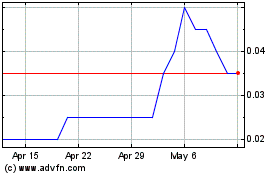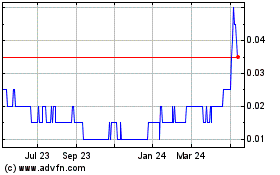Arctic Star Expands Nickel Discovery at Credit Lake, Providence Lake Greenstone Belt, NT
August 13 2008 - 2:12PM
Marketwired Canada
Arctic Star Diamond Corp. (TSX VENTURE:ADD) ("Arctic Star" or the "Company")
reports assays, 1.68% nickel, 0.99% copper, 0.17% cobalt, 0.34 ppm platinum, and
2.23 ppm palladium from 1.65 metres of massive sulphides. These are the first
results received from its ongoing drilling program from a new nickel discovery
on its 100% owned Credit Lake property, in the Northwest Territories (NT).
Massive sulphide in lenses up to 5.1m thick have now been intersected in 7 of
the 9 holes completed in this program. Disseminated sulphide zones also exist in
all holes drill to date.
In April 2008, Arctic Star discovered disseminated, stringer and massive
sulphides with significant nickel, copper and cobalt values. In mid-July Arctic
Star returned to Credit Lake to continue exploration on this new discovery.
Exploration underway includes prospecting, soil sampling, geological mapping,
geophysics and diamond drilling. Drilling has followed a 30m vertical and
horizontal step out protocol in the discovery area. Arctic has now nine drill
holes into this program and they are successfully defining the shape and extent
of this komatiite and amphibolite hosted nickel mineralization.
The results reported today from the first diamond drill hole (DDH) in the
current drill program, DDH 08CR-11 which intersected matrix and massive sulphide
30m below the same intercept reported in the first hole, DDH 08CR-10 (see News
Releases May 27 and June 4, 2008). Mineralized komatiitic lavas occur from
127.7m to 152.4m in DDH 08CR-11. Within the komatiite, a lense of 1.65m of
massive sulphides, occurs between 139.75m and 141.4m, it was this interval that
was rushed to the lab. The massive sulphide results from both holes are reported
below in table 1.
The rush assay results from DDH 08CR-11 confirm the nickel, copper cobalt
results of the first hole continue at depth and of particular note the assays
confirm the mineralization contains platinum and palladium. Table 1 lists the
massive sulphide assays received to date.
Table 1:- RUSH ORE-GRADE ASSAY RESULTS: - see note below table
--------------------------------------------------------------------------
inter- Plati- Palla-
Az/Dip from to val Copper Nickel Cobalt num dium
Hole # Degrees (m) (m) (m) % % % ppm ppm
--------------------------------------------------------------------------
O8CR-10 180/-45 117.6 117.8 0.2 2.92 1.34 0.125 assays awaited
118.2 118.8 0.6 0.46 1.77 0.164 assays awaited
08CR-11 190/-45 139.75 141.4 1.65 0.99 1.68 0.170 0.34 2.23
--------------------------------------------------------------------------
Samples from DDH 08CR-10 (BTW split core) were sent to ALS Chemex
laboratory in Thunder Bay, Ontario; Samples from DDH 08CR-11 (BQTW split
core) were sent to SRC Laboratories in Saskatoon, Saskatchewan. At both
laboratories the split core was crushed and pulverized and then assayed
using aqua-regia or 3-acid digestion with atomic absorption spectrometry
finish. Fire Assay was used to determine Platinum and Palladium.
Surface mapping near the discovery has revealed that the nickel sequence
outcrops in the area. Interestingly these outcropping sulphides had been
trenched and sampled by other workers in the past, possibly for gold or VMS, but
not for nickel. The mapping shows the sequence is striking at 100 degrees E-W
and dipping to the north at 70 degrees. The drill orientation has been adjusted
to intersect these rocks perpendicular to strike. Table 2 lists each hole
drilled to date and states where komatiite and amphibolite hosted disseminated
and massive sulphide have been intersected. To date massive sulphide has been
drill confirmed over 100m of strike and 120m (vertical) depth. The drilling in
part is designed to determine the dip and plunge of the sulphides and until this
work is completed it is not yet possible to calculate true widths. If the
sulphides continue to dip at 70 degrees the current drill hole intercepts will
be estimating true widths to within 7%. An Innov-X x-ray fluorescence Mobilab
device is being used to confirm the presence of elevated nickel, copper and
cobalt to guide drilling. Each mineralized drill core interval is sawed in two,
then systematically sampled and sent to laboratory for assay. Pulps collected
while sawing drill core will be used in Arctic Star's quality control and
quality assurance program.
Table 2:- Mineralized Komatiite, Amphibolite, and Massive Sulphide
intercepts
--------------------------------------------------------------------------
Inter-
Az/Dip Depth From To val MS Intervals
Hole # Degrees (m) (m) (m) (m) (m)
--------------------------------------------------------------------------
08CR-10 180/-45 142.3 102 134.7 32.7 0.2, 0.6 (2 lenses)
O8CR-11 190/-45 177 141.4 152.4 11.0 1.65
08CR-12 190/-45 143.24 91.44 99.7 8.26 1.48
08CR-13 190/-55 159.4 97.0 105.2 8.2 1.05, 1.25, 1.00
(3 lenses)
08CR-14 190/-45 181.34 146.55 154.65 8.1 0.3
08CR-15 190/-45 176.7 135.65 141.45 5.8 0.01
08CR-16 190/-45 91.4 not intersected
08CR-17 190/-45 112.7 97.4 99.7 2.3 (Amphibolite hosted)
08CR-18 190/-52 137 98.4 103.5 5.1 (Amphibolite hosted)
Note MS equals massive sulphides
This discovery is the first insitu occurrence of nickel mineralization reported
in the Slave geological province, with grades that suggest the Providence Lake
Greenstone (PLG) Belt has the potential to produce economic nickel
mineralization. The PLG belt includes large volumes of mafic and ultramafic
rocks, and includes tholeiitic basalts, komatiites, serpentinized peridotite,
and gabbro intrusions. The PLG belt features deep-penetrating faults,
sulphur-bearing sediments in the form of sulphide bearing iron-formation and
black shales, and massive sulphides. Arctic Star geologists believe this
discovery is only the first in an extensive land package with similar geology
and airborne geophysical anomalies.
Arctic Star Diamond Corp, controls 37km of the PLG belt in two 100% owned
projects: Credit Lake and New Bigg.
The qualified persons for this news release are Mr. K. R. Kivi, P.Geol., and Mr.
B. Doyle as defined by National Instrument 43-101.
On Behalf of the Board of Directors
Arctic Star Diamond Corp.
Patrick Power, President and CEO
This news release contains Forward Looking Statements regarding our intentions
and plans. Various factors may prevent or delay our plans, including but not
limited to, contractor availability and performance, weather, access, mineral
prices and success and failure of the exploration and development carried out at
various stages of the program. Readers should review risk factors applicable to
junior mining exploration companies generally to understand the variety of risks
that can affect the Company.
Arctic Star Exploration (TSXV:ADD)
Historical Stock Chart
From Jan 2025 to Feb 2025

Arctic Star Exploration (TSXV:ADD)
Historical Stock Chart
From Feb 2024 to Feb 2025
